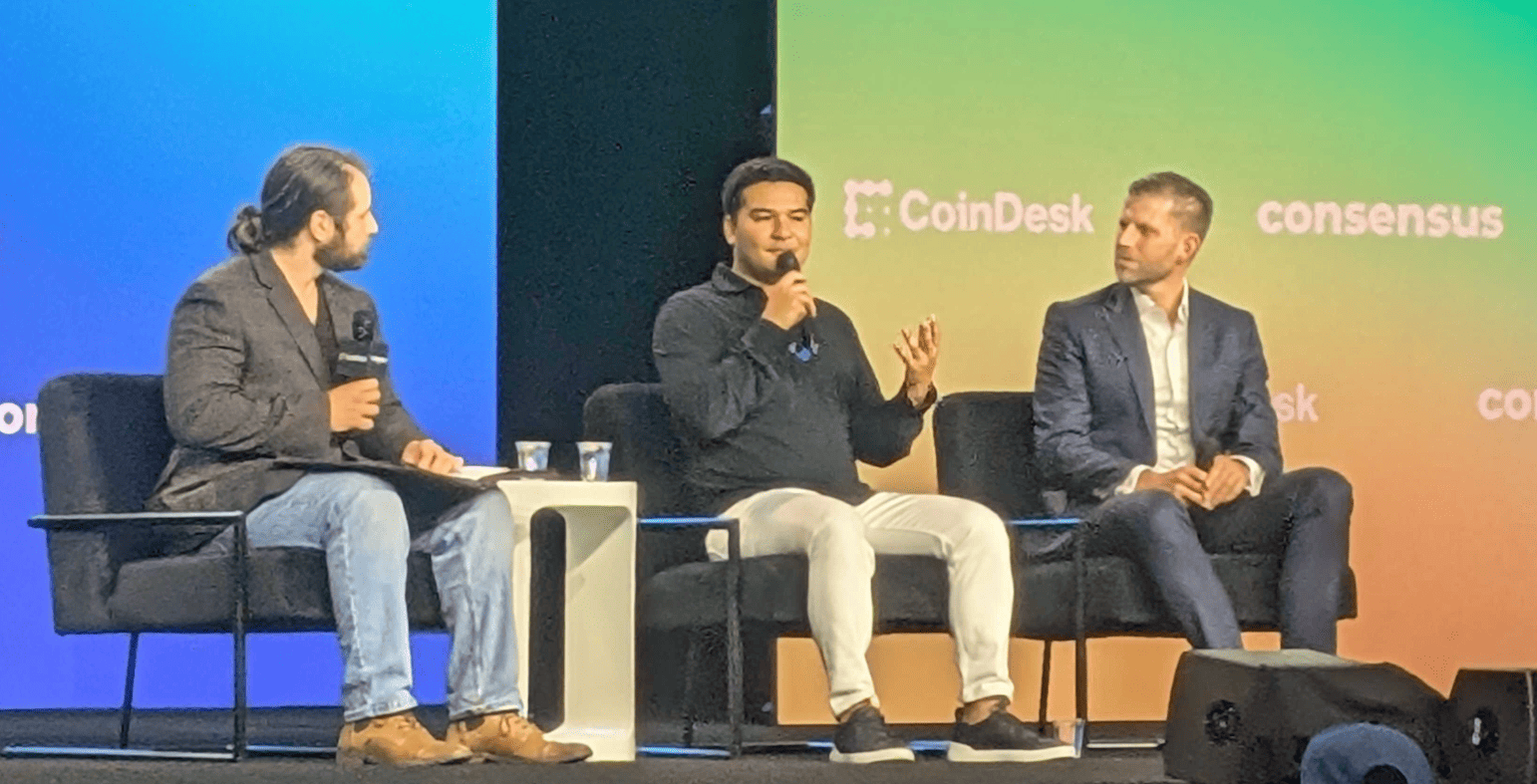On May 15, 2025, the "Consensus Cryptocurrency Conference" held in Toronto, Canada, became the eye of the storm in the global digital asset field. The speeches by Eric Trump, a core second-generation member of the Trump family, and Paul Grewal, Chief Legal Officer of Coinbase, not only revealed the crazy hoarding trend of Bitcoin among global sovereign funds, enterprises, and billionaires but also pushed the deep-seated contradictions of U.S. crypto legislation to the forefront - when political power and blockchain capital are deeply intertwined, the battle for rule-making rights in a trillion-dollar market has entered a white-hot stage.
I. Global Bitcoin Hoarding Trend and the Trump Family's Crypto Empire Expansion

Asher Genoot and Eric Trump at the 2025 Consensus Conference.
"I can feel this frenzy even on the plane - now everyone in the world is trying to hoard Bitcoin, sovereign wealth funds, top billionaire families, and multinational giants without exception," Eric Trump said directly in his keynote speech. As the second son of Trump and co-founder of the Bitcoin mining company American Bitcoin, he vividly outlined a global landscape of digital gold competition.
According to his disclosure, this race has two main lines: "accumulation race" and "mining race". The former, represented by Michael Saylor, founder of MicroStrategy, continuously purchases Bitcoin to counter fiat currency inflation; the latter focuses on energy and computing power competition, with the Trump family being an important participant. Just three days before the conference (May 12), Eric-led American Bitcoin announced a stock swap merger with mining company Gryphon Digital Mining, planning to go public on NASDAQ via SPAC mode, which is seen as a key step in the Trump family's expansion into the crypto capital market.
In fact, the Trump family's crypto territory has long exceeded the mining industry. From loudly issuing "Trump Coin" (TRUMP) and "Melania Coin" (MELANIA) and other MEME coins in 2024, to collaborating with UAE sovereign funds to launch USD1 stablecoin, and building a "dollar + blockchain" hybrid financial ecosystem through the World Liberty Financial platform, their business tentacles have penetrated the entire industry chain, including trading, payment, and asset management.
Democratic Senator Elizabeth Warren sharply pointed out: "This is not just a business layout, but a power monetization machine under the guise of compliance using political influence."
II. Regulatory Dilemma under Political Bargaining: GENIUS Bill Becomes Focus of Bipartisan Struggle

On May 15, Paul Grewal (right) spoke at the Toronto Consensus Conference.
While Eric was advocating the "Bitcoin Revolution" at the conference, the legislative battlefield in Washington was stuck due to the Trump family's crypto interests. Coinbase's Chief Legal Officer Grewal candidly said in the panel discussion: "The technical issues of the GENIUS Bill could have been resolved, but the presidential family's cryptocurrency relationships have added unprecedented challenges to bipartisan consensus."
This bill aimed at establishing a federal regulatory framework for stablecoins has been stalled since passing the initial Senate Banking Committee review in March 2025 due to the Democratic Party's collective defection. The core point of contention is whether the Trump family converts political influence into commercial interests through platforms like World Liberty Financial. Data shows that Trump's personal crypto assets are valued at $2.9 billion, accounting for 40% of his net worth, with the USD1 stablecoin directly linked to a $2 billion cooperation project with the UAE, and $TRUMP meme coin holders can even bid for the qualification to "have dinner with the president".
Democratic Senator Richard Blumenthal denounced: "This is the most blatant rent-seeking of power since the constitutional 'compensation clause'!"
Although the Republican Party tried to save the deadlock with a "streamlined bill" - removing restrictions on the president's crypto assets and weakening state regulatory requirements - the Senate's 48:49 vote on May 9 still announced a temporary setback in the legislative process. Grewal revealed that both parties are negotiating over consumer protection and anti-money laundering clauses, and if the Democrats' concerns about the "Trump factor" cannot be resolved, the second vote may not break through before May 26.
III. Dilemma of Crypto Giants and Industry Future: Where to Go on the Compliance Path?
Facing the double attack of regulatory vacuum and political uncertainty, the anxiety of compliant giants like Coinbase is palpable. Grewal emphasized: "Stablecoin legislation is the cornerstone of rebuilding market confidence, but the current discussion has deviated from the technical essence and become a political performance show." He cited data showing that the bill's suspension has caused $12 billion in institutional funds to pause entry, while offshore stablecoin USDT further consolidates its "black box operation" advantage with a 90% market share.
This dilemma is similarly evident in the simultaneously advancing "Digital Asset Market Structure Act" in the House of Representatives. As an upgraded version of the FIT21 bill, this legislation attempts to clarify token security attributes and exchange compliance paths but has cooled again due to Democratic accusations of "opening a backdoor for Trump's corruption". Senator Kirsten Gillibrand frankly said: "When the president's family's business is highly bound to policy, any technical clause could become a tool for interest transfer."
Despite this, the industry remains cautiously optimistic about the long-term prospects.
Eric revealed at the conference that American Bitcoin is negotiating cooperation with Japan's Metaplanet and Middle Eastern sovereign funds, planning to build a cross-continental Bitcoin strategic reserve network, which subtly echoes the "National Bitcoin Reserve" policy promoted during the Trump administration. Analysts point out that if the U.S. can emulate Brazil (planning to convert 5% of foreign exchange reserves to Bitcoin) or El Salvador (Bitcoin legalization), it may reshape global capital flows, but political internal friction is making this vision increasingly distant.
IV. Crypto World at Historical Crossroads: Technical Idealism vs Political Reality
Under the spotlight of the Toronto Consensus Conference, the fierce collision between blockchain technology's decentralized ideals and political reality was fully exposed. When Eric shouted, "This is not gambling, but a revolution," the audience applauded thunderously; but when Grewal mentioned that "code cannot solve power corruption," the venue fell into deep thought.
The outcome of this game may profoundly impact the global financial order. If the GENIUS bill ultimately passes through compromise, the U.S. may consolidate its digital dollar hegemony through stablecoins; conversely, the accelerated implementation of the EU's MiCA framework and Singapore's regulatory sandbox may quietly shift Western financial highlands. For ordinary investors, the tug-of-war between the Trump family's "shill magic" and the Democratic Party's "anti-corruption banner" means more intense market volatility and policy risks.
As Satoshi Nakamoto etched in the Genesis Block - "Chancellor on brink of second bailout for banks" - today's crypto world once again stands at the critical point of confrontation between traditional power and technological innovation. When the sovereign race to hoard Bitcoin meets the power game of the legislative body, the answer may not be on the podium in Toronto, but in every line of immutable chain code.







